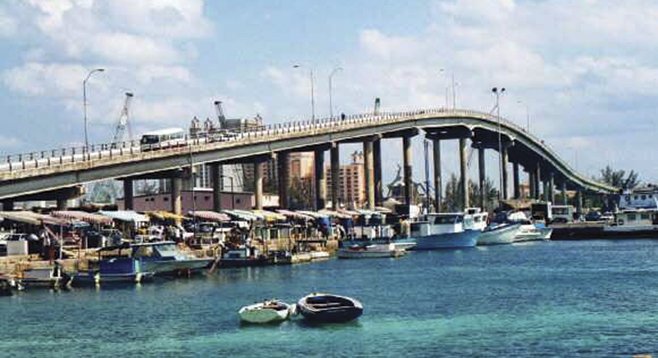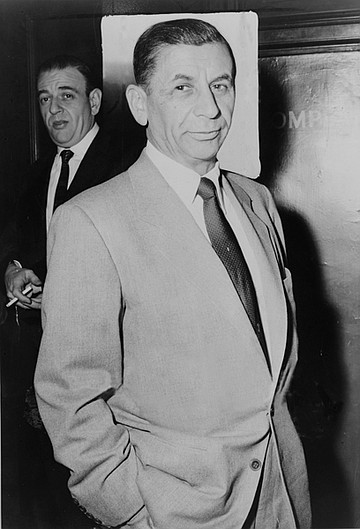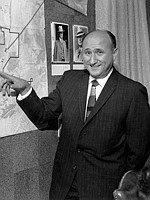 Facebook
Facebook
 X
X
 Instagram
Instagram
 TikTok
TikTok
 Youtube
Youtube

Citizens are wringing their hands — wisely, in my opinion — about Mitt Romney’s long-standing practice of stashing money in havens such as Switzerland and the Cayman Islands. But during the Republican nomination race, then-candidate Newt Gingrich declared, “I don’t know of any American president who has had a Swiss bank account.”
Wrong, Newt. As a self-proclaimed historian, you should have read about Richard Nixon. According to reliable reports — not widely publicized — Nixon had a bundle of money in a now-defunct Swiss bank with smelly clients, particularly in San Diego.
The bank, which closed in 1974, was based in Zurich, but it had a branch in Nassau, the Bahamas, and its law firm and some operations were in New York City. It was named the Cosmos Bank. (Full disclosure: I began investigating Cosmos in 1970 and provided much information on it to Business Week magazine and Forbes magazine.)
Researchers have found that Cosmos was deeply involved with mobbed-up casino operations in the Bahamas and so was Nixon, often with his friend Bebe Rebozo. After Fidel Castro drove the Mafia out of Cuba, mob moneybags Meyer Lansky looked to the Bahamas for a casino haven.

Huntington Hartford, heir to a grocery fortune, set up a casino in the Bahamas and initially wanted it free of mob influence. But that was not to be, and Hartford eventually sold most of his holdings. Hartford told Dan E. Moldea, author of several organized-crime books, that Nixon made three deposits totaling $35,883,070 in the Cosmos Bank between October 21, 1971, and June 11, 1972.
Anthony Summers, author of The Arrogance of Power: The Secret World of Richard Nixon, wrote that according to documents seized by the Internal Revenue Service, the Nixon deposits in Cosmos were under the heading “N&R.” In the 1980s, Nixon, sometimes accompanied by his wife Pat and sometimes by Rebozo, “traveled to Zurich every single year,” according to Summers’s book.
The Cosmos Bank invested heavily in the Paradise Island Bridge, which transported gamblers to the Bahamian casino in which Lansky associates were allegedly involved. Summers interviewed Robert Morgenthau, the former organized-crime–fighting district attorney of New York County and onetime United States attorney for the Southern District of New York. Morgenthau had interviewed Cosmos Bank officials. He concluded that they were holding a big investment in the bridge for Nixon. “Could I prove it? No. Am I sure of it? Yes,” Summers quoted Morgenthau saying.
According to Business Week, “The Senate Watergate Committee and the special prosecutor’s office looked into the Cosmos Bank, among others, to learn if it was a conduit for illegal Republican campaign contributions.” The bank’s New York lawyer and a board member William G. Dillon (with whom I tangled several times) told the magazine, “The bank is being deliberately misidentified. A few years ago, if Rebozo or Nixon or anyone else came to us, we’d be flattered. But it didn’t happen.” Hmmm.

Cosmos was created in 1959. According to the book Masters of Paradise: Organized Crime and the Internal Revenue Service in the Bahamas, “A few years after its creation, Cosmos was strategically placed in a controversial American land development scheme involving organized crime. In 1964, Cosmos loaned millions of Swiss francs to builder Irvin J. Kahn for his Rancho Peñasquitos project near San Diego, California.” It was a concealed loan. “One of the conditions of the hidden loan called for Kahn to purchase a $1 million life insurance policy naming Cosmos as the beneficiary.” Hmmm.
Continued Summers’s book, “The agreement was a prerequisite for vastly larger loans [for the Peñasquitos project] from the racketeer-managed Teamsters Central States Fund. With the permission of Cosmos, Kahn borrowed very heavily from the pension fund.”
As Forbes pointed out, Kahn, who died in 1973, “was involved in numerous deals with principals related to organized crime.” He was close to St. Louis mob/Teamsters lawyer Morris Shenker, with whom he invested in the notorious Dunes Hotel in Las Vegas. Oh, yes. Kahn money also helped develop parts of Clairemont.
Cosmos plunked money into San Diego’s U.S. Financial, a real estate conglomerate based on phony accounting, whose principals ended up in the pokey. Among other Cosmos investments: Equity Funding, a financial conglomerate once called the “fraud of the century,” and Westec, which went bankrupt shortly after Cosmos got involved. Executives went to the slammer in both of those well-publicized frauds.
U.S. Financial, Equity Funding, and Westec were not particularly good investments for Cosmos. But its most notorious involvement, with a Cleveland conglomerate named A-T-O, was enormously remunerative — for Cosmos and other insiders, but not for the little guys, who got skinned when the stock completely fell apart. (Cosmos dumped more than two-thirds of its stock before the crash.)
The chief executive of A-T-O, Harry Figgie, a Harvard MBA, claimed he was a managerial genius. He could make an acquisition in one day, he asserted, as he forecast tremendous earnings growth. Wall Street believed him and sent the stock soaring, although analysts observed insiders, including Cosmos, dumping their stock rapidly. They had paid 8 cents each for their shares and were jettisoning them for 50,000 percent profits or more. As Forbes pointed out, many of those insiders were the same ones who made fat profits in other stocks pumped up by the Teamsters-tainted brokerage house that had brought out A-T-O.
In those days, it was against the law for a Swiss bank to reveal if it was holding stock for somebody else. Growled Dillon, Cosmos Bank’s lawyer and a board member, to me, “It’s ours, it’s ours, it’s ours, and it isn’t anybody else’s. There is no Mr. X in Italy or the United States.”
Deadpanned the book The Big Time: The Harvard Business School’s Most Successful Class and How It Shaped America, “A-T-O’s first bank — the Cosmos Bank of Zurich — had profited a tidy $20 million by its timely liquidations.”
But there is no record that Richard Nixon got in on that one. ■


Citizens are wringing their hands — wisely, in my opinion — about Mitt Romney’s long-standing practice of stashing money in havens such as Switzerland and the Cayman Islands. But during the Republican nomination race, then-candidate Newt Gingrich declared, “I don’t know of any American president who has had a Swiss bank account.”
Wrong, Newt. As a self-proclaimed historian, you should have read about Richard Nixon. According to reliable reports — not widely publicized — Nixon had a bundle of money in a now-defunct Swiss bank with smelly clients, particularly in San Diego.
The bank, which closed in 1974, was based in Zurich, but it had a branch in Nassau, the Bahamas, and its law firm and some operations were in New York City. It was named the Cosmos Bank. (Full disclosure: I began investigating Cosmos in 1970 and provided much information on it to Business Week magazine and Forbes magazine.)
Researchers have found that Cosmos was deeply involved with mobbed-up casino operations in the Bahamas and so was Nixon, often with his friend Bebe Rebozo. After Fidel Castro drove the Mafia out of Cuba, mob moneybags Meyer Lansky looked to the Bahamas for a casino haven.

Huntington Hartford, heir to a grocery fortune, set up a casino in the Bahamas and initially wanted it free of mob influence. But that was not to be, and Hartford eventually sold most of his holdings. Hartford told Dan E. Moldea, author of several organized-crime books, that Nixon made three deposits totaling $35,883,070 in the Cosmos Bank between October 21, 1971, and June 11, 1972.
Anthony Summers, author of The Arrogance of Power: The Secret World of Richard Nixon, wrote that according to documents seized by the Internal Revenue Service, the Nixon deposits in Cosmos were under the heading “N&R.” In the 1980s, Nixon, sometimes accompanied by his wife Pat and sometimes by Rebozo, “traveled to Zurich every single year,” according to Summers’s book.
The Cosmos Bank invested heavily in the Paradise Island Bridge, which transported gamblers to the Bahamian casino in which Lansky associates were allegedly involved. Summers interviewed Robert Morgenthau, the former organized-crime–fighting district attorney of New York County and onetime United States attorney for the Southern District of New York. Morgenthau had interviewed Cosmos Bank officials. He concluded that they were holding a big investment in the bridge for Nixon. “Could I prove it? No. Am I sure of it? Yes,” Summers quoted Morgenthau saying.
According to Business Week, “The Senate Watergate Committee and the special prosecutor’s office looked into the Cosmos Bank, among others, to learn if it was a conduit for illegal Republican campaign contributions.” The bank’s New York lawyer and a board member William G. Dillon (with whom I tangled several times) told the magazine, “The bank is being deliberately misidentified. A few years ago, if Rebozo or Nixon or anyone else came to us, we’d be flattered. But it didn’t happen.” Hmmm.

Cosmos was created in 1959. According to the book Masters of Paradise: Organized Crime and the Internal Revenue Service in the Bahamas, “A few years after its creation, Cosmos was strategically placed in a controversial American land development scheme involving organized crime. In 1964, Cosmos loaned millions of Swiss francs to builder Irvin J. Kahn for his Rancho Peñasquitos project near San Diego, California.” It was a concealed loan. “One of the conditions of the hidden loan called for Kahn to purchase a $1 million life insurance policy naming Cosmos as the beneficiary.” Hmmm.
Continued Summers’s book, “The agreement was a prerequisite for vastly larger loans [for the Peñasquitos project] from the racketeer-managed Teamsters Central States Fund. With the permission of Cosmos, Kahn borrowed very heavily from the pension fund.”
As Forbes pointed out, Kahn, who died in 1973, “was involved in numerous deals with principals related to organized crime.” He was close to St. Louis mob/Teamsters lawyer Morris Shenker, with whom he invested in the notorious Dunes Hotel in Las Vegas. Oh, yes. Kahn money also helped develop parts of Clairemont.
Cosmos plunked money into San Diego’s U.S. Financial, a real estate conglomerate based on phony accounting, whose principals ended up in the pokey. Among other Cosmos investments: Equity Funding, a financial conglomerate once called the “fraud of the century,” and Westec, which went bankrupt shortly after Cosmos got involved. Executives went to the slammer in both of those well-publicized frauds.
U.S. Financial, Equity Funding, and Westec were not particularly good investments for Cosmos. But its most notorious involvement, with a Cleveland conglomerate named A-T-O, was enormously remunerative — for Cosmos and other insiders, but not for the little guys, who got skinned when the stock completely fell apart. (Cosmos dumped more than two-thirds of its stock before the crash.)
The chief executive of A-T-O, Harry Figgie, a Harvard MBA, claimed he was a managerial genius. He could make an acquisition in one day, he asserted, as he forecast tremendous earnings growth. Wall Street believed him and sent the stock soaring, although analysts observed insiders, including Cosmos, dumping their stock rapidly. They had paid 8 cents each for their shares and were jettisoning them for 50,000 percent profits or more. As Forbes pointed out, many of those insiders were the same ones who made fat profits in other stocks pumped up by the Teamsters-tainted brokerage house that had brought out A-T-O.
In those days, it was against the law for a Swiss bank to reveal if it was holding stock for somebody else. Growled Dillon, Cosmos Bank’s lawyer and a board member, to me, “It’s ours, it’s ours, it’s ours, and it isn’t anybody else’s. There is no Mr. X in Italy or the United States.”
Deadpanned the book The Big Time: The Harvard Business School’s Most Successful Class and How It Shaped America, “A-T-O’s first bank — the Cosmos Bank of Zurich — had profited a tidy $20 million by its timely liquidations.”
But there is no record that Richard Nixon got in on that one. ■
Comments